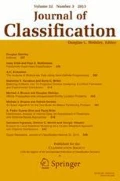Abstract
Classifiers for a highly imbalanced dataset tend to bias in majority classes and, as a result, the minority class samples are usually misclassified as majority class. To overcome this, a proper undersampling technique that removes some majority samples can be an alternative. We propose an efficient and simple undersampling method for imbalanced datasets and show that the proposed method outperforms others with respect to four different performance measures by several illustrative experiments, especially for highly imbalanced datasets.




Similar content being viewed by others
References
Bahnsen, A. C., Aouada, D., Stojanovic, A., & Ottersten, B. (2016). Feature engineering strategies for credit card fraud detection. Expert Systems with Applications, 51, 134–142.
Beckmann, M., Ebecken, N. F., & De Lima, B. S. P. (2015). A KNN undersampling approach for data balancing. Journal of Intelligent Learning Systems and Applications, 7, 104.
Blaszczynski, J., & Stefanowski, J. (2015). Neighbourhood sampling in bagging for imbalanced data. Neurocomputing., 150, 529–542.
Cai, R., Zhao, Q., She, D. P., Yang, L., Cao, H., & Yang, Q. Y. (2014). Bernoulli-based random undersampling schemes for 2D seismic data regularization. Applied Geophysics, 11, 321–330.
Chawla, N. V. (2010). “Data mining for imbalanced datasets: An overview”, In Data Mining and Knowledge Discovery Handbook (pp. 875-886). Springer.
Chyi, Y.M. (2003). “Classification analysis techniques for skewed class distribution problems”, Master Thesis, Department of Information Management, National Sun Yat-Sen University.
Dal Pozzolo, A., Caelen, O., Le Borgne, Y. A., Waterschoot, S., & Bontempi, G. (2014). Learned lessons in credit card fraud detection from a practitioner perspective. Expert Systems with Applications, 41, 4915–4928.
Galar, M., Fernandez, A., Barrenechea, E., & Herrera, F. (2013). EUSBoost: Enhancing ensembles for highly imbalanced data-sets by evolutionary undersampling. Pattern Recognition, 46, 3460–3471.
Garcia, S., & Herrera, F. (2009). Evolutionary undersampling for classification with imbalanced datasets: Proposals and taxonomy. Evolutionary Computation, 17, 275–306.
Garica-Pedrajas, N., Perez-Rodriguez, J., Garcia-Pedrajas, M., Ortiz-Boyer, D., & Fyfe, C. (2012). Class imbalance methods for translation initiation site recognition in DNA sequences. Knowledge-Based Systems, 25, 22–34.
Japkowicz, N., & Stephen, S. (2002). The class imbalance problem: A systematic study. Intelligent Data Analysis, 6, 429–449.
Kang, P., & Cho, S. (2006). “EUS SVMs: Ensemble of under-sampled SVMs for data imbalance problems”, In Neural Information Processing (pp. 837-846).
Krawczyk, B., Galar, M., Jelen, Ł., & Herrera, F. (2016). Evolutionary undersampling boosting for imbalanced classification of breast cancer malignancy. Applied Soft Computing, 38, 714–726.
Liu, X. Y., Wu, J., & Zhou, Z. H. (2009). Exploratory undersampling for class-imbalance learning. IEEE Trans Syst Man Cybern B Cybern, 39, 539–550.
Majid, A., Ali, S., Iqbal, M., & Kausar, N. (2014). Prediction of human breast and colon cancers from imbalanced data using nearest neighbor and support vector machines. Computer Methods and Programs in Biomedicine, 113, 792–808.
Maldonado, S., & Lopez, J. (2014). Imbalanced data classification using second-order cone programming support vector machines. Pattern Recognition, 47, 2070–2079.
Napierala, K., & Stefanowski, J. (2015). Addressing imbalanced data with argument based rule learning. Expert Systems with Applications, 42, 9468–9481.
Passos, I. C., Mwangi, B., Cao, B., Hamilton, J. E., Wu, M. J., Zhang, X. Y., Zunta-Soares, G. B., Quevedo, J., Kauer-Santanna, M., Kapczinski, F., & Soares, J. C. (2016). Identifying a clinical signature of suicidality among patients with mood disorders: A pilot study using a machine learning approach. Journal of Affective Disorders, 193, 109–116.
Provost, F., & Fawcett, T. (2013). “Fitting a model to data”, in Data Science for Business: What you need to know about data mining and data-analytic thinking. California: O’Reilly Media.
Quinlan, J.R. (2014). C4.5: Programs for Machine Learning. Elsevier.
Steinley, D., & Brusco, M. (2007). Initializing K-means batch clustering: A critical evaluation of several techniques. Journal of Classification., 24, 99–121.
Sundarkumar, G. G., & Ravi, V. (2015). A novel hybrid undersampling method for mining unbalanced datasets in banking and insurance. Engineering Applications of Artificial Intelligence, 37, 368–377.
Tutz, G. (2012). Regression for categorical data. Cambridge University Press.
Wang, K. J., Adrian, A. M., Chen, K. H., & Wang, K. M. (2015). A hybrid classifier combining borderline-SMOTE with AIRS algorithm for estimating brain metastasis from lung cancer: A case study in Taiwan. Computer Methods and Programs in Biomedicine, 119, 63–76.
Wilson, D. L. (1972). Asymptotic properties of nearest neighbor rules using edited data. IEEE Transactions on Systems, Man, and Cybernetics, 3, 408–421.
Yen, S. J., & Lee, Y. S. (2009). Cluster-based under-sampling approaches for imbalanced data distributions. Expert Systems with Applications, 36, 5718–5727.
Yu, H., Ni, J., & Zhao, J. (2013). ACOSampling: An ant colony optimization-based undersampling method for classifying imbalanced DNA microarray data. Neurocomputing, 101, 309–318.
Funding
This work has been supported by the National Research Foundation of Korea(NRF) grant funded by the Korea government(MSIT)(2019R1A2C1088255), and Research Project Program for Newly-Recruited Personnel funded by the Ministry of Science and Technology of Taiwan, R.O.C. (MOST 108 - 2218 - E - 027 - 008 - MY2).
Author information
Authors and Affiliations
Corresponding author
Additional information
Publisher’s Note
Springer Nature remains neutral with regard to jurisdictional claims in published maps and institutional affiliations.
Rights and permissions
About this article
Cite this article
Ahn, G., Park, YJ. & Hur, S. A Membership Probability–Based Undersampling Algorithm for Imbalanced Data. J Classif 38, 2–15 (2021). https://doi.org/10.1007/s00357-019-09359-9
Published:
Issue Date:
DOI: https://doi.org/10.1007/s00357-019-09359-9




